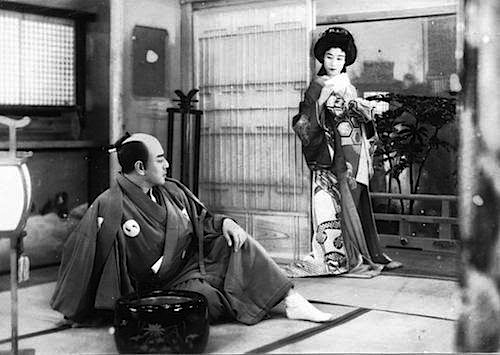
By Joe Bendel. Only Hollywood could turn the 47 Ronin into a flop. It is considered the most adapted story in the history of film, but the essence of its appeal eluded the much delayed studio bomb. There are plenty of versions to try, including films by Mizoguchi and Ichikawa. However, it was Teinosuke Kinugasa who helmed the first sound production. Best known for the Criterion collected Gate of Hell, Kinugasa was a prolific filmmaker comfortable working in many genres. Yet, his Chushingura, as 47 Ronin stories are formally referred to, apparently exists only on one surviving print. If you ever hope to see it, act now when Kinugasa’s Chushingura screens as part of Japan Speaks Out, MoMA’s current survey of early Japanese talking pictures.
Hopefully, someone will invite Scorsese to the upcoming screening, because Kinugasa’s Chishingura demands the full restoration treatment. The print in question can be a little hazy and crackly at times. It is generally frustrating to see cinematic heritage in such a state, but there is something weirdly eerie about the print’s sometimes ghostly look. Viewers can easily work with it, if they are willing to.
For the first sound treatment, Kinugasa was not about to make radical departures from the familiar narrative. The unfortunate provincial Lord Asano is indeed undermined by the scheming Lord Kira, inadvertently committing a social faux pas in the Shogun’s palace due to the senior nobleman’s gamesmanship. Rather put out by the situation, Asano draws his sword on Kira, which is an even greater offense. Sentenced to commit seppuku, Asano’s clan is disbanded and his holdings are confiscated by Kira. This does not sit well with his loyal retainers, led by their commander, Oishi Kuranosuke. They will take their time pretending to adopt new civilian lives, but eventually they will make their move.
Even with the less the optimal print, Kinugasa’s sense of visual composition is striking. One can sometimes see a kinship with his expressionistic avant-garde silents, A Page of Madness and Crossroads. (Seriously, this film needs to go to the top of the preservation list.) He also gets some fine performances from a cast that could not possibly be fully at home with talkies yet. Kinugasa focuses more on the rank-and-file Ronin than the lords and the honor-bound Kuranosuke (more of a Picard than a Kirk this time around). In fact, some of those subplots are wonderfully tragic, such as the junior Ronin who falls in love with a servant girl who transfers into Lord Kira’s service.
There have been hundreds of Chushinguras (someone ought to release a box set of silent and early talkies for jidaigeki fans), but the 1932 version is both historically significant and entertaining in its own right. Frankly, it is worth seeing just as the work of Kinugasa, most of whose films are not widely available outside of Japan. Although they cannot say with absolute certainty, the programmers suspect this is the first time his talkie Chushingura has screened in America and given the availability of prints, it is not likely to pop up again anytime soon. Therefore the 1932 Chushingura is very highly recommended for fans of the Ronin and samurai dramas in general when it screens again this coming Tuesday (5/19) at MoMA, as part of Japan Speaks Out.
LFM GRADE: A-
Posted on May 14th, 2015 at 4:54pm.